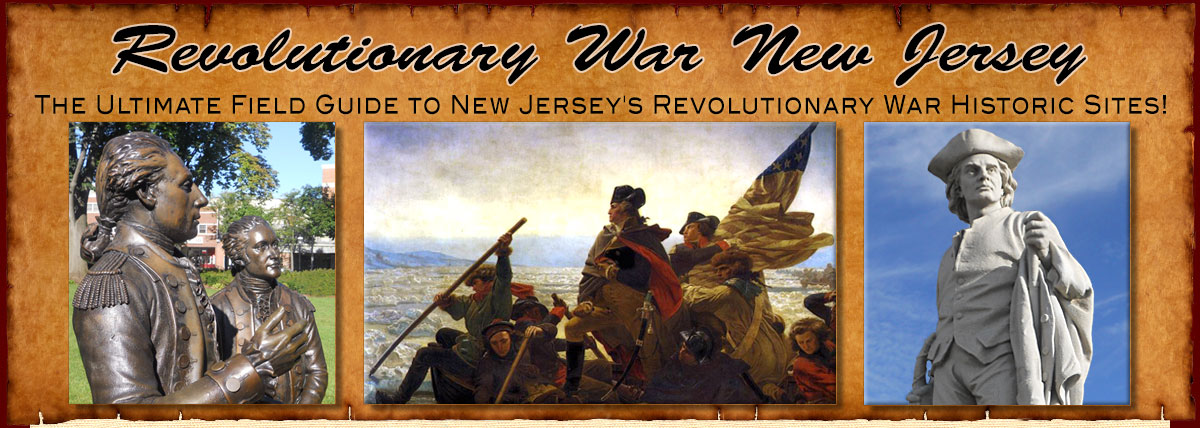

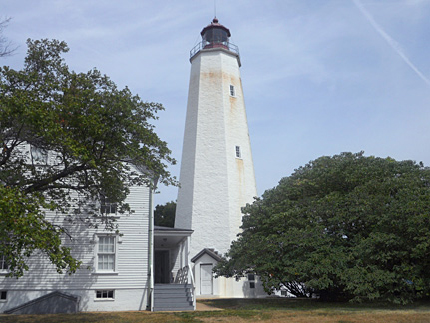
Sandy Hook Lighthouse
Hartshorne Dr.
Map / Directions to all Sandy Hook Revolutionary War Sites
For current hours and admission information:
https://www.nps.gov/gate/planyourvisit/sandy-hook.htm
Built in 1764, the Sandy Hook Lighthouse is the oldest standing lighthouse in the country. [1] Because of Sandy Hook's location just miles across New York Harbor, the lighthouse served the important function of facilitating the safety of ships coming in and out of New York.
One week after it was first lit June 11, 1764, The New York Mercury ran a notice about the opening of the lighthouse. The notice goes into great detail about the size and dimensions of the lighthouse, as this must have been particularly impressive at the time. Keep in mind as you read this, that this notice was written over a century before anyone had ever seen a skyscraper, and when most buildings were only a few stories high, which gives a feeling for how impressive a structure this must have been to someone seeing it in 1764: [2]
"On Monday Evening last, the New-York Light House, erected at Sandy Hook, was lighted for the first Time. The House is of an Octagon Figure, having eight equal Sides; the Diameter at the Base 29 Feet ; and at the Top of the Wall, 15 Feet. The Lanthorn [Lantern] is 7 Feet high; the Circumference 33 Feet. The whole Construction of the Lanthorn is Iron; the Top covered with Copper. There are 48 Oil Blazes. The Building from the Surface is Nine Stories; the whole from Bottom to Top 103 Feet. This Structure, was undertaken by Mr Isaac Conro, of this City and was carried on with all the Expedition that the Difficulty attending to and fro on the Occasion could possibly admit of; and is judged to be masterly finished."
As the Revolutionary War heated up, concerns grew about the likelihood of an invasion of British ships and troops into New York City. Since the lighthouse would be a great help to British ships in the event of an invasion, both the New Jersey Provincial Congress and the New York Convention of Delegates resolved to damage or destroy the lighthouse, to hinder the movement of British ships into New York Harbor.
From New York, Major William Malcolm was chosen to lead a mission to attack the Sandy Hook lighthouse. Malcolm's March 6, 1776 orders read:
"The Provincial Congress of this Colony having appointed us a committee to concert measures for carrying into execution their resolve of the 5th inst. for the dismantling the light-house at Sandy-Hook; we, reposing especial trust and confidence in your abilities and zeal in the common cause, have made choice of you for the execution of that important enterprise. We enclose you a certified copy of the resolve for that purpose, and desire you will conform, as nearly as may be, to the strict letter thereof. You will please to call upon the committee of Middletown, or such other place in New-Jersey as you shall judge most proper, for the assistance you shall think necessary. Upon your arrival at Sandy Hook you will endeavour to take the glass out of the lantern, and save it if possible; but if you find this impracticable you will break all the glass. You will also endeavour to pump the oil out of the cisterns into casks and bring it off; but if you should be obstructed by the enemy, or not be able to procure casks, you will pump it out on the ground. In short you will use your best discretion to render the light-house entirely useless."[3]
When Major Malcolm reached Middletown, he linked up with men of the Monmouth County Militia, commanded by Colonel George Taylor (who is buried in the Throckmorton-Lippit-Taylor Burying Ground in Middletown). On March 8, they landed on Sandy Hook and proceeded to the lighthouse. They confiscated a number of items essential to the functioning of the lighthouse: eight copper lamps, two block and tackles, and three and a half casks of oil. They were unable to remove and save the glass, and so they broke it. [4]
A series of skirmishes took place on Sandy Hook in the time following. By May, the British were in control of the Sandy Hook peninsula, and it would remain in British hands until the end of the war. By the end of June, the British had repaired the lighthouse and it was fully operational. There were further attacks made on the light house by American troops, beginning with an attack on June 21, 1776, under the command of Lieutenant Colonel Benjamin Tupper. Tupper gave the following description of the attack:
"This Morning about 4 o'clock we attacked the Light House with about 300 Men; they were strongly reinforced being (as I saw a Boat go on board from Long-Island) previously informed of our Design. I continued the Attack for two Hours with Field Pieces and small Arms, being all that Time between two smart Fires from the Ship- ping and the Light House, but could make no Impression on the Walls. I then re- turned to my Camp at the South End of the Cedars, which I have occupied two Days and, Nights, and after refreshing my Men, sent out 50 to see for Game; they have this Minute attacked them with Small Arms, and seven Boats are making from the Land to the Ships. My Men are all well, and in high Spirits, not one of them being either killed or wounded." [5]
There would be future attacks on the lighthouse, but the British retained control of the lighthouse, and of Sandy Hook for the rest of the war. Sandy Hook remained in the hands of the British for longer than any other location in the country during the Revolutionary War. [6]
The Sandy Hook Lighthouse was declared a National Historic Landmark on June 11, 1964, the 200th anniversary of its first lighting. It still serves its original function as a light house for ships coming in and out of New York harbor. It is now lit 24 hours a day with a powerful modern light maintained by the United States Coast Guard that is visible for nineteen miles on a clear night.
The lighthouse now stands much farther from the tip of Sandy Hook than it did at the time of the Revolutionary War. When originally built, the lighthouse stood just 500 feet from the tip of Sandy Hook. As ocean currents have moved sand up the coast over the years, the tip has been extending farther and farther out into the harbor. As a result, the lighthouse now stands about one and one half miles from the northern tip of Sandy Hook. [7]

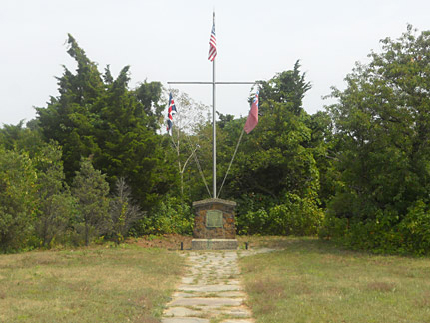
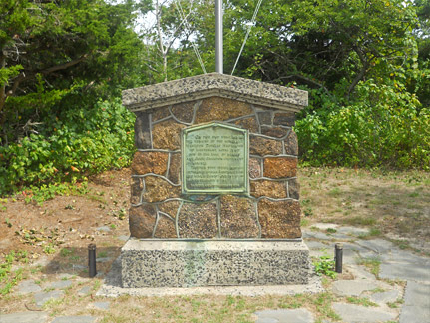
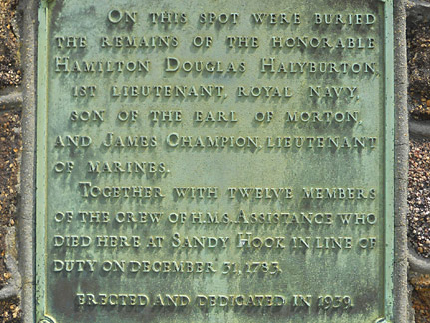
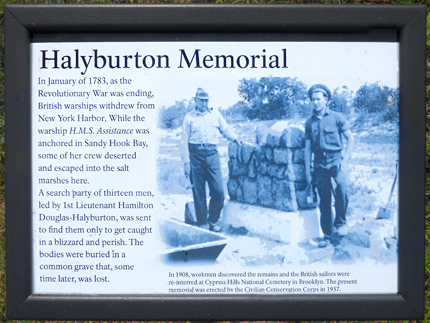
Hamilton Douglas Halyburton Memorial
Hartshorne Dr.
Map / Directions to all Sandy Hook Revolutionary War Sites
The Treaty of Paris was signed September 3, 1783, officially ending the Revolutionary War. Due to the slowness of Atlantic Ocean travel in the 1780s, it took almost two months for the news to reach America. On October 31, General Washington received the news in Kingston NJ, and Congress received the news while meeting in Princeton, NJ.
British troops began to leave the United States over the ensuing weeks. New York City had been occupied by the British since 1776. On November 25, now known as Evacuation Day, the last British troops left New York, and General Washington made a triumphal return to the city. However, although all troops had left the city, there were still British ships in and around New York Harbor who had not yet sailed back to England.
The story behind the Hamilton Douglas Halyburton memorial involves one of those ships, the warship H.M.S. Assistance. On December 30, 1783, five sailors from the Assistance were sent ashore to Sandy Hook to get fresh water. These men deserted. The following day another six sailors did the same. Later that day (December 31), a barge with a crew of fourteen men was sent ashore to find the deserters. In command was 1st Lieutenant Hamilton Douglas Halyburton. As the snow continued to fall, the crew did not return to the Assistance. By January 2, the snow had stopped. A boat was sent ashore to look for the men, and it was discovered that Halyburton and the search party had frozen to death in the snow. They were buried at this site the following day. The deserters were never found. [8]
Hamilton Douglas Halyburton came from a distinguished and wealthy family of Scottish nobility. He was the second son of Sholto Charles Douglas, the Earl of Morton. [9] After Hamilton's death at Sandy Hook, his mother Katherine, the Countess Dowager of Morton, had a marble monument erected at the site of the graves. The text on the front of the monument read: [10]
Here lie the remains of the Honorable Hamilton Douglass Haliburton, son of Shoto Charles, Earl of Morton, and heir of the ancient family of Haliburton, of Pitcurr in Scotland, who perished on this coast, with twelve more young gentlemen and one common sailor, in the spirited discharge of duty, the 30th or 31st of December, 1783 - born October the 10th, 1763: a youth who in contempt of hardship and danger, though possessed of an ample fortune, served seven years in the British navy, with a manly courage. He seemed to be deserving of a better fate. To his dear memory, and that of his unfortunate companions, this monumental stone is erected, by his unhappy mother Katherine Countess Dowager of Morton.
James Champion - Lieutenant of Marines
Alexander Johnstone, George Paddy, Robert Haywood - Midshipmen
Charles Gascoigne, Andrew Hamilton, William Scott, Dave Reddie, William Tomlinson, William Spry, John McChain, Robert Wood - Young Gentlemen
George Towers - Sailor
Cast away, all found dead and frozen, and buried in this grave.
Of his Britannic majesty's ship Assistance: Mr. Haliburton, First Lieutenant
Around 1808, an armed French vessel landed on Sandy Hook. This was during the time of the Napoleonic Wars, with France at war with Great Britain and some of the French crewmen destroyed this monument to British sailors. Nothing of that original monument remains.
A second marble memorial from Halyburton's mother hangs in the Trinity Church in Manhattan. It has similar, but different, text than the monument had. It was presumably made around the time of the monument, but there is no record of how and exactly when this memorial made its way to Trinity. [11] (If you go to Trinity Church to view this Monument Stone, note that Alexander Hamilton is buried in the cemetery, where there is a monument to him. Hamilton has many New Jersey Revolutionary War connections, and received the wound that killed him in his July 11, 1804 duel with Aaron Burr in Weehawken NJ.)
After the destruction of the original monument, the sailors' graves lay here unmarked and forgotten as decades passed. Then, in April 13, 1908, the remains of the fourteen sailors were accidently discovered while workers were digging at the area. Their bodies were then reinterred at the Cypress Hills Cemetery in Brooklyn. [12]
The current Halyburton Memorial was built in 1937 as part of the New Deal program, the Citizens Conservation Corps. A plaque at the site (pictured bottom row right) shows a photo of two workers during the construction of the memorial in 1937. (Please note that the plaque has incorrect information on it. It begins, "In January 1783..." but none of the events involving Hamilton Douglas Halyburton and the H.M.S. Assistance occurred in January 1783.)
Although the Memorial was built in 1937, the plaque was not placed on it until 1939. Queen Elizabeth and King George VI of England visited the United States in June 1939, and were to pass through Sandy Hook on June 10. As part of the preparation for their brief visit through Sandy Hook, a plaque was placed on the then two-year old memorial, with the misleading caption, "Erected and Dedicated in 1939." The Royal Couple did pass by the site of the monument, but unfortunately it appears that they did not stop. The following day they would visit the New York's World Fair, and then go on to meet with President Franklin and First Lady Eleanor Roosevelt at Hyde Park. Their visit to Hyde Park became a subject of the 2012 film Hyde Park on Hudson. [13]
And so this story which began at the end of the Revolutionary War, wove its way through the erection of the original monument in the 1780s, the destruction of that monument during the Napoleonic wars, and then through the accidental discovery of the bodies in 1908, ended with a visit from the King and Queen of England less than three months before the start of World War II !

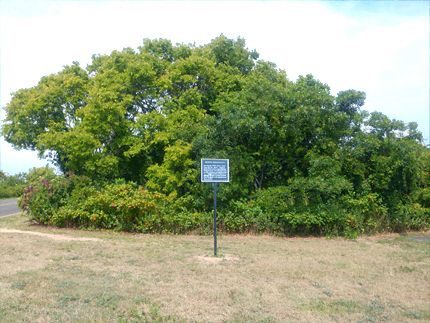
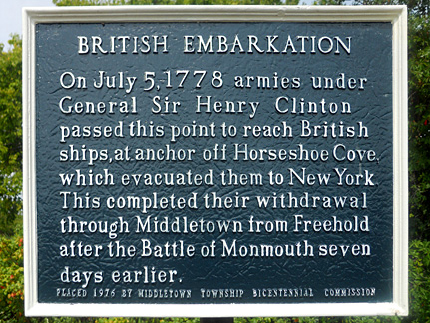
British Embarkation Marker
Hartshorne Dr.
Map / Directions to all Sandy Hook Revolutionary War Sites
After the Battle of Monmouth on June 28, 1778, British troops under General Henry Clinton retreated from Freehold through Middletown to Sandy Hook. (A series of signs in Middletown marks the route of their retreat, and the site of their campsite.) On July 5, 1778 these troops reached Sandy Hook's Horseshoe Cove, where British ships were anchored. The ships evacuated the troops to New York, which had been occupied by the British since late 1776, and would be until the end of the Revolutionary War. [14]

1. ^ Historically Famous Lighthouses CG-232 (United States Coast Guard), p. 63
Available to be read at the Internet Archive here
• Pages 33-34 of this work are about the Boston Lighthouse, which was first lighted September 14, 1716, forty-eight years before the Sandy Hook lighthouse. However, the original Boston Lighthouse was destroyed by the British during the Revolutionary War. A new Boston lighthouse was built on the site of the old one in 1783.
Therefore, the Sandy Hook lighthouse is the oldest original, standing lighthouse in the country.2. ^ This June 18, 1764 New Jersey Mercury article was reprinted in the Archives of New Jersey:
William Nelson, editor Archives of the State of New Jersey, First Series, Vol XXIV (Extracts from American Newspapers relating to New Jersey, Vol X 1762-1765) (Paterson, The Call Printing and Publishing Company, 1902) p.380
Available digitized in Google Books here3. ^ Pierre Van Cortlandt, Abm. P. Lott, and John Sloss Hobart of the New York Provincial Congress to Major William Clark March 6, 1776, which appears in:
William Bell Clark. Editor, Naval Documents of the American Revolution Vol. 4. (U.S. Navy Department, Washington, DC, 1968) p. 194 195.
• Electronically published by American Naval Records Society; Bolton Landing, New York, 2012
Available as a PDF here (Note that while it is pages 194 and 195 of the original document, it is on page 51 and 52 of this PDF)
• Note that page 194 also contains the letter that Major Malcolm was given to take with his orders to the New Jersey Committees of Inspection and Observation
4. ^ William Bell Clark. Editor, Naval Documents of the American Revolution Vol. 4. (U.S. Navy Department, Washington, DC, 1968) p. 309-310.
• Electronically published by American Naval Records Society; Bolton Landing, New York, 2012,
Available as a PDF here (Note that while it is pages 309-310 of the original document, it is on pages 165-166 of this PDF)
The pages contain the following document:"Honble [Honourable] John Hancock
President.of the Continental Congress. -
Ordered, That a copy thereof be engrossed, and signed by the President, and transmitted.Die Martis, 3 ho. P.M. March 12, 1776
Mr. [John Sloss] Hobart informed the Congress that Major Malcom [William Malcolm], who was sent to dismantle the light-house, was returned, and had executed that matter effectively, with the assistance of Colo. Geo. Taylor and some of his men; that Major Malcom found it impossible to take out and save the glass, as well for want of tools as by reason of the time necessary for that purpose, and was therefore obliged to break it; that Major Malcom had delivered the lamps and oil, two tackle falls and blocks, removed from the light-house, to Colo. George Taylor, and taken a receipt for the same, which was read and filed.
[Then follows the receipt from Colonel Taylor]
Middletown, March 8th, 1776.
Received from William Malcom; eight copper lamps, two tackle falls and blocks and three cask, and a part of a cask of oil, being articles brought from. the light-house on Sandy Hook, and which I will deliver to him, or to the order of the Provincial Congress of the colony of New-York, when called for.
George Taylor, Colonel."5. ^ William Bell Clark. Editor, Naval Documents of the American Revolution Vol. 5. (U.S. Navy Department, Washington, DC, 1968) p. 663.
• Electronically published by American Naval Records Society; Bolton Landing, New York, 2012,
Available as a PDF here (Note that while it is page 663 of the original document, it is on page 109 of this PDF)6. ^ Michael S. Adelberg, " 'So Dangerous a Quarter' The Sandy Hook Lighthouse During the American Revolution," The Keeper's Log: Journal of the United States Lighthouse Society, April 1995, p 10 - 15.
Available to be read online here
• For those interested in a lengthier account of the Sandy Hook Lighthouse, I highly recommend this article, which was valuable in my understanding of the events surrounding the lighthouse.
Adelberg's book The American Revolution in Monmouth County - The Theatre of Spoil and Destruction (Charleston; The History Press, 2010) also gives further information about the lighthouse during the war, and how it related to the fighting between local Patriots and Loyalists.
7. ^ Details in the last two paragraphs of this entry, regarding National Historic Landmark status, modern usage, and the distance from the tip of Sandy Hook, were all drawn from
Sandy Hook Lighthouse Brochure (National Park Service / U.S. Department of the Interior / Gateway National Recreation Area)
Available as a PDF on the National Park Service Website here
8. ^ George H. Moss, Jr. Nauvoo to the Hook - The Iconography of a Barrier Beach (Locust, NJ, Jervey Close Press, 1964) p. 29 - 37, and p. 111 -112
Chapter III The Hamilton Douglas-Story is a well written and researched account of the events concerning Hamilton Douglas Halliburton and the H.M.S. Assistance. This work served as a valuable starting point to my understanding of this event, from which I located further information and sources. I recommend this book to anyone interested. The book is currently out of print. I located a copy in the reference section of the Clifton NJ Public Library• The names of the eleven deserters are given on page 33 of Nauvoo to the Hook - The Iconography of a Barrier Beach. Moss states that these names appeared in the muster book of the H.M.S. Assistance
Michael Broderick: Age 21, Born in Tipperary
Jonathan Cooney: Age 21, Born in Dublin
Anthony Crane
George Dicks: 28, Born in Portsmouth
Bernard Innes: Age 24, Born in London
William McDonald: Age 22, Born in Greennough, Scotland
Thomas Martin: Age 22, Born in Wexford, Ireland
Jonathan Morris: Age 21, Born in Bristol
Thomas Murphy: Age 31, Born in Dublin
Jonathan Shears: Age 22, Born in Broadhampton
Samuel West: Age24, Born in Richmond• As to why these men chose to desert, the reason is unknown.
However, the following book provides some possible insight into this:
Edward Pelham Brenton, Captain in the Royal Navy The Naval History of Great Britain, from the Year MDCCLXXXIII. to MDCCCXXXVI, Volume I (London, Henry Colburn, 1837) pages 261-262
Available to be read at Google Books here
On page 261 of this book (published 54 years after the end of the Revolutionary War), Captain Brenton complains that Americans openly encouraged British enlisted sailors to desert their ships. Brenton wrote, "The conduct of the United States of North America, after the acknowledgment of their independence had manifested irritation and unfriendliness towards Great Britain. While the French met with the most cordial reception in their ports, we were scarcely admitted to the common rights of hospitality. In the whole of our intercourse with them from the year 1783 to 1812, insult and injury constantly attended the arrival of every British ship in what were called 'the waters of the United States.' If a boat landed, the seamen were enticed to desert, and often openly paraded the streets in defiance of their officers; the magistrates of the republic refused to interfere and exulted in the mortification of their hated and unwelcome visitors."
Brenton goes directly from this paragraph into a paragraph about the H.M.S. Assistance event, although he incorrectly gives the year as 1787.• The chronology of events from December 31-January 2 can be traced in the entries of Captain William Bentinck's Log of the H.M.S. Assistance. On page 32 of Nauvoo to the Hook - The Iconography of a Barrier Beach, Moss quotes a sizable chunk of the logs from December 31 to January 8, from which the following excerpts are quoted. (Moss notes that his source was "Unpublished Crown-copyright material in the Public Record Office transcribed in this book appears by permission of the Controller of H. M. Stationery Office". It is now 50 years later, and I was unable to determine what the current copyright/use status of this text is. As such, I have only quoted these excerpts, which should fall under the category of Fair Use.)
"Wednesday Dec. 31st, 1783 (Winds) NE b E
Moored in Sandy Hook Bay -
First part moderate and cloudy with Snow. midday Weather - fresh Breezes & squally...
Sent the Launch on Board the Transport with 7 empty Casks [referring to casks to fill with fresh water]. found that the people had rose & taken the Boat. manned & armed the Barge and sent here in Chase of herThursday Jan. 1st 1784 (Winds) NNE
Moderate and cloudy with Snow... The Barge was not returnedFriday Jan. 2nd 1784 (Winds) N
A.M. light Breezes and clear, sent the Cutter on Shore in Search of the Launch & BargeSaturday Jan. 3rd 1784 (Winds) N b W
Slight Breezes & cloudy. at 4 the Cutter returned with the Barge. informing us that the Barge had swampt the Hon [oura] ble Hamilton Douglas Hallyburton 1st Lieut., Lieut. Champion of Marines and Messrs Haywood, Hamilton, Gascoigne, Spry, Towers, Faddy, Wood, - Tomlinson, Reddy, Johnstone, & Scott Midshipmen& Jno. McChien, Seaman, were perished & all picked up except Messrs Hamilto, Wood & Tomlinson. sent on Board the Hermoine & Sophie for Carpenters employed making coffins, at 10 A.M. sent the deceased bodies on Shore to be buried."9. ^ Sir James Balfour Paul, L.L.D., The Scots Peerage - Founded on Wood's Edition of Sir Robert Douglas's Peerage of Scotland - Containing an Historical and Genealogical Account of the Nobility of that Kingdom - Volume VI (Edinburgh, T. and A. Constable, 1909)
The "Douglas, Earl of Morton" chapter is about the history of the family. Pages 383-384 discuss Hamilton Douglas Halyburton, and his mother and father.
Available to be read at the Internet Archives here
10. ^ Transcription of the text of the monument appeared in:
John Warner Barber, Henry Howe, Historical Collections of the State of New Jersey, (New York, S. Tuttle, 194 Chatham-Square, 1846) p. 362
Available to be read at Google Books here• Moss states in his notes for Nauvoo to the Hook - The Iconography of a Barrier Beach (page 111) that he believes that Barber and Howe derived the text of the monument from the 1789 book The American Universal Geography by Jedidiah Morse.
However, I was unable to locate any place in The American Universal Geography where Morse shows the text of the monument, although he does mention the monument on page 524.
Available to be read at the Internet Archives here.11. ^ I spoke with Anne Petrimoulx, who is the Archivist at the Trinity Wall Street Archives, by phone on February 12, 2014. She informed me that the church does not have any records as to when and how the memorial arrived at the church.
She did provide me with a copy of an article that appeared on pages 16-17 of the Dec 1964 Trinity Parish Newsletter, "Sandy Hook on New Year's Ever 1783." The article was written by George H. Moss around the time of the publication of his book Nauvoo to the Hook - The Iconography of a Barrier Beach in 1964. In the article he relates that his own research, and the records of the church in 1964, could not resolve the origin of the stone in Trinity. He does state that it was most likely originally placed at the second Trinity Church circa 1790. (The current Trinity Church is actually the third church structure at this location. The First Trinity Church was chartered by King William III of England in 1697, and was destroyed by fire in 1776 during the British occupation of New York. Second Trinity Church was built 1788-1790 and torn down 1839. The third and current structure was completed in 1846. Source: Trinity Wall Street History Timeline, which appeared on the Trinity website)
I would like to thank Anne for taking the time to speak with me, and for providing me with a copy of the newsletter article.
• The text of the marble memorial inside Trinity Wall Street Church, 74 Trinity Place, New York City is similar to, but not the same, as the text that is recorded to have appeared on the monument at Sandy Hook.
The full text of the memorial stone at Trinity reads:"At Sandy Hook lye Interred The Remains OF THE HONOURABLE HAMILTON DOUGLAS HALLYBURTON, Son of SHOLTO CHARLES EARL OF MORTON and Heir to the Ancient Family of HALLYBURTON of PITCURR in SCOTLAND, who perished on this Coast with Twelve more young gentlemen and one common Seaman, in the spirited Discharge of Duty:
on the 30th or 31st of December 1783
Born on the 10th of October 1763.
A Youth who in contempt of hardship or Danger: though possessed of an ample Fortune served seven years in the British Navy with a manly Courage and seemed to deserve a better fate.
This plain Monumental stone is erected by his unhappy Mother KATHERINE COUNTESS DOWAGER OF MORTON to his clear memory and that of his unfortunate companions.
JAMES CHAMPION - Lieutenant of Marines
ALEXANDER JOHNSTONE, GEORGE PADDY, ROBERT HAYWOOD - Midshipmen
CHARLES GASCOIGNE, ANDREW HAMILTON, WILLIAM SCOTT, DAVE REDDIE, WILLIAM TOMLINSON, WILLIAM SPRY, JOHN McCHAIN, ROBERT WOOD - Young Gentlemen
GEORGE TOWERS - common seaman
Cast away, all found dead and frozen, and buried in one Grave."12. ^ Several contemporary articles described the finding of the graves:
• "Skeletons Unearthed" Red Bank Register, Red Bank NJ, April 22, 1908, Page 1
Available to be read online at the Red Bank Register Archives here (Article is in the right-hand column of page 1)• "Unearth Skeletons at Sandy Hook" New York-Daily Tribune, April 20, 1908, page 4.
Available to be read at the Library of Congress website here (Article is near the bottom of the second column from the right)
When this article was written, there was a question as to the identities of the skeletons found, which was cleared up in another article the following day:
"Sandy Hook Mystery Solved" New York-Daily Tribune, April 21, 1908, page 6.
Available to be read at the Library of Congress website here (Article is near the bottom of the right hand column)
• "British Praise of American Courtesy - Admiralty Acknowledges Kindness in Burying Bodies of Officers Frozen in 1783," New York Times, September 6, 1908
Available to be read at the New York Times website here• There is conflicting information in these articles as to what type of work was being done that uncovered the graves. The Red Bank Register stated that the skeletons were unearthed "by some workmen who were grading for a branch of the railroad." The New York Times article stated that the discovery was made, "in the course of certain excavations upon the military reservation, Fort Hancock, New Jersey, with a view to the erection of Government buildings."
In his "Sandy Hook On New Year's Eve 1783" article, Moss states that it was railroad work, but it is unclear if he is basing this on the Red Bank Register article, or on additional information.
• Also, the Red Bank Register article and the first New York-Daily Tribune article report sixteen skeletons were found. Since there were only 14 sailors, this was apparently early incorrect information.
• Only the Red Bank Register gives a date for the actual discovery of the skeletons (April 13). Because there seems to be other confusion of information in these articles, I have chosen to simply state April 1908 for the discovery in the main entry. That said, April 13 may have been the actual date, and it certainly occurred around this date.13. ^ Support for the 1937 / 1939 timeline, and that the plaque was made ready for the Royal visit can be found in the following sources:
• Sandy Hook, Gateway NRA, NPS Oral History Interview with Albin Zwiazek 52nd Coast Artillery, Battery C, 1937-1939 Interviewed by Tom Hoffman, NPS February 17, 1980 In 2 CDs. Transcribed by Jo Anne Carlson 2008
Available as a PDF at the National Park Service website hereMr. Zwiazek served at Fort Hancock on Sandy Hook 1937-1939 (or 1940). He is interviewed for this oral history by Fort Hancock Park Technician Historian Tom Hoffman
The following excerpts of this oral history (on page 19 - 21 of the PDF) concern the details of the Royal Visit, and its relation to the memorial.
ALBIN ZWIAZEK: And then the King and Queen came here in 1939, June 10th. I remember that day and I just checked on my paper work. I had a letter of Commendation from General Drum and it was talked about the June 10, 1939 visit by the King and Queen. I know I'm accurate on the date. They landed in Red Bank and C Battery had the detail of the Guard of Honor detail here. E Battery went to Red Bank. We didn't go to Red Bank we were on the pier here. They landed and came by train to Red Bank. E Battery was out there and they furnished the Guard of Honor. Many men from Headquarters were strung along the road here facing the water on both sides, the Bay or the Ocean. They never saw the King and Queen, they weren't allowed to look. They were supposed to look out there. This peninsula was surrounded by Coast Guard and Naval vessels. At the Main Gate, which was a little bit past the...
TOM HOFFMAN: ... our present Main Gate, the south end of Sandy Hook....
ALBIN ZWIAZEK: The 16th Infantry came down from Fort Jay with machine guns and they had machine guns posted there. We were quarantined here for seventy-two hours. No one could leave or come in. We searched every place that you could possible hide on this Post. Brush, cellars, where you people finally found some ammunition. We tramped all over that area 'cause we hit everything. For three days we searched around to make sure that there was no one here who didn't belong here. And the place was ringed with Naval ships and Coast Guard all around. I never saw something like that in my life. When they got here into Red Bank, they got into cars and drove into Fort Hancock. Drove through leisurely down in front of Officers' Row, to the docks, and they got on the WARRINGTON, the Destroyer and they went up to the Battery. From there they went up to the World's Fair and the next day I think they had hot dogs at Roosevelt's estate in Hyde Park. They just came through here. They just stood on the pier for a little while.
TOM HOFFMAN: Where were you on that day?
ALBIN ZWIAZEK: We were, C Battery, was on the pier.
TOM HOFFMAN: Right out here on the Fort Hancock wharf.
ALBIN ZWIAZEK: I can't place exactly where it was now because it's changed around.
TOM HOFFMAN: They've taken it down. The Coast Guard took out the wharf.
ALBIN ZWIAZEK: They got out of the vehicles there and got on the ship. The Coast Guard Cutter Campbell was out there also and fired a 21 gun salute. These guns here fired a 21 gun salute. Some members from Headquarters did it, I don't know who right out here in front of Headquarters.
TOM HOFFMAN: Did they have the whole road from Red Bank out to Sandy Hook lined?
ALBIN ZWIAZEK: Well I don't know outside of the Post.
TOM HOFFMAN: But from the South end up to the wharf.
ALBIN ZWIAZEK: Each man could see the next man. I think they called that Cossack duty. They all faced away from the street there guarding the roadway. And the King and Queen went by behind them. There were other people too that came along during that trip. We have a picture showing Governor Moore and I think the Prime Minister of Canada or something. They had the State Troopers. There were others that came here too.
TOM HOFFMAN: To your knowledge, that day, do you know if the King and Queen stopped at the Halyburton Monument?
ALBIN ZWIAZEK: They didn't stop there, from what I've been told. All the guys set up the Monument and all, and they didn't stop there. All the guys that were there said this. I wasn't there, but from what I understand from all the men that were posted around that area, they never stopped. They drove by, slowly probably, but they didn't stop.
TOM HOFFMAN: Just prior to the King and Queen coming, were the soldiers thinking that they would probably stop?
ALBIN ZWIAZEK: They were set. They got that plaque up there and everything, they were getting ready for that. They knew they were coming. They were all charged up and they were ready because that Monument was made maybe a couple of years before that.
TOM HOFFMAN: It was made by Mike Lakomie in 1937 and they got the plaque ready[. T]hat's why it reads "erected and dedicated June 1939'". But that's deceiving. The plaque was made just prior to June 1939. They just put the whole thing on there just to say that. But it was actually built by Mike Lakomie, Company 288, Civilian Conservation Corps Camp, Sandy Hook in the summer of 1937. So it was probably a little disappointing that they go riding by.
ALBIN ZWIAZEK: Like I said, I wasn't there but a lot of the other fellas were posted near there and they said they didn't stop at all, just went by. Maybe it was pointed out to them.
• A June 10, 1939 newspaper article about the Royal Couple's visit, "Royalty Greeted in Red Bank" in the Evening Leader of Corning NY, can be read Here
The article stated, "Later the King and Queen, Governor and Mrs. Moore and the royal party entered 25 waiting automobiles for a half hour auto ride through the countryside to Fort Hancock on Sandy Hook where they boarded the U.S.S. Destroyer Leader Warrington for the ride across New York Bay to New York."• Thomas Hoffman, Fort Hancock (from the Images of America series) (Charleston SC; Arcadia Publishing 2007) p.116-117
shows photos from 1937 of the monument being constructed. One of the photos shows the completed monument in 1937, but without the plaque.
These are great photos, and can be seen as they appear in the book in Google Books here• Information about the Halyburton Memorial at The National Park Service List of Classified Structures states that the memorial was "Built 1937, dedicated in 1939."
14. ^ Marker place in 1976 by the Middletown Township Bicentennial Commission